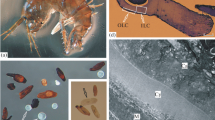Abstract
By means of histochemical and electron-microscopic techniques, two pigments were identified in the brown body of the earthworm Eisenia fetida andrei. Lipofuscin, often called the aging pigment, was the more abundant pigment and the first to be synthesized. Melanin was also found but was only present in the mature brown body. A computer-assisted image analysis was used to quantify the relative abundance of the two pigments at different stages of the formation of the brown body. A previous study showing phenoloxidase activity in the coelomocytes and the present demonstration of the ability of these cells to produce reactive oxygen systems when agglutinated can be correlated with the simultaneous presence of the two pigments in the brown body. The physiological significance of pigment synthesis by brown bodies is discussed with respect to the immune response in earthworms.
Similar content being viewed by others
References
Babior BM, Kipnes RS, Curnutte JT (1973) Biological defense mechanisms: the production by leukocytes of superoxide, a potential bactericidal agent. J Clin Invest 52:741–744
Crippa R, Horak V, Prota G, Svoronos P, Wolfram L (1989) Chemistry of melanins. In: Brossi A (ed) The alkaloids: chemistry and pharmacology, vol 25. Academic Press, London, pp 253–323
Davies KJA (1987) Protein damage and degradation by oxygen radicals. 1. General aspects. J Biol Chem 262:9895–9901
Dikkeboom R, Tijnagel JMG, Mulder EC, Van Der Knaap WPW (1987) Hemocytes of the pond snail Lymnaea stagnalis generate reactive forms of oxygen. J Invert Pathol 49:321–331
Essner E, Novikoff AB (1960) Human hepatocellular pigments and lysosomes. J Ultrastruct Res 3:374–381
Feeney L (1978) Lipofuscin and melanin of human retinal pigment epithelium. Invest Ophthalmol Visual Sci 17:583–600
Fischer E (1977) The function of chloragosomes, the specific agepigment granule of annelids: a review. Exp Geront 12:69–74
Gabe M (1968) Techniques histologiques. Masson, Paris
Ganter P, Jollés G (1969) Pigments In: Gancter P, Jollés G (eds) Histochimie normale et pathologique, vol 1. Gauthier-Villars, Paris, pp 815–923
Goebel HH (1987) Ultrastructure of disease-related lipopigments. In: Zs Nagy I (ed) Lipofuscin-1987: state of the art. Akadémiai Kiado, Budapest and Elsevier, Amsterdam, pp 319–340
Goldfischer S, Villaverde H, Forschirm R (1966) The demonstration of acid hydrolase, thermostable reduced diphosphopyridine nucleotide tetrazolium reductase and peroxidase activities in human lipofuscin pigment granules. J Histochem Cytochem 14:641–652
Ivy GO, Schottler F, Wenzel J, Baudry M, Lynch G (1984) Inhibitors of lysosomal enzymes: accumulation of lipofuscin-like dense bodies in the brain. Science 226:985–987
Klebanoff SJ (1988) Phagocytic cells: products of oxygen metabolism. In: Galin JI, Goldstein IM, Synderman R (eds) Inflammation basic principles and clinical correlates. Raven Press, New York, pp 391–444
Lassègues M, Roch P, Valembois P (1989) Antibacterial activity of Eisenia fetida andrei coelomic fluid: evidence, induction and animal protection. J Invert Pathol 53:1–6
Miyagishi T, Takahata N, Iizuka R (1967) Electron microscopic studies of the lipopigments in the cerebral cortex of nerve cells of senile and vitamin E-dificient rats. Acta Neuropathol 9:7–17
Nakamura N, Mori K, Inooka S, Nomura T (1985) In vitro production of hydrogen peroxide by the amoebocytes of the scallop, Patinopecten yessoensis (Jay). Dev Comp Immunol 9:407–417
Nappi AJ, Christensen BC, Tracy JW (1987) Quantitative analysis of hemolymph monophenol oxidase activity in immune reactive Aedes aegypti. Insect Biochem 17:685–688
Nathan CF, Cohn ZA (1980) Role of oxygen-dependant mechanisms in antibody-induced lysis of tumor cells by activated macrophages. J Exp Med 152:198–208
Pearse AGE (1985) Pigments and pigment precursors. In: Pearse AGE (ed) Histochemistry, 4th edn, vol 2. Churchill Livingstone, London, pp 874–928
Pipe RK (1992) Generation of reactive oxygen metabolites by the haemocytes of the mussel Mytilus edulis. Dev Comp Immunol 16:11–122
Porchet-Henneré E, Vernet G (1992) Cellular immunity in an annelid (Nereis diversicolor, Polychaeta): production of melanin by a subpopulation of granulocytes. Cell Tissue Res 269:167–174
Prota G (1988) Progress in the chemistry of melanins and related metabolites. Med Res Rev 8:525–556
Samorajski T, Keefe JR, Ordy JM (1965) The fine structure of lipofuscin age pigment in the nervous system of aged mice. J Cell Physiol 26:779–788
Semal Van Gansen P (1957) Le lipopigment des chloragosomes des Lombriciens. Ann Histochimie 2:41–55
Seymour J, Nappi AJ, Valembois P (1993) Characterization of a phenoloxidase of the coelomic fluid of the earthworm Eisenia fetida andrei by electrochemical detection and electrophoresis. Anim Biol (in press)
Tappel AL (1973) Lipid peroxidation damage to cell components. Fed Proc 32:1870–1874
Taylor RL (1969) A suggested role for the polyphenol phenoloxidase system in invertebrate immunity. J Invert Pathol 14:427–428
Valembois P, Seymour J, Roch P (1991) Evidence and cellular localization of an oxidative activity in the coelomic fluid of the earthworm Eisenia fetida andrei. J Invert Pathol 57:177–183
Valembois P, Lassegues M, Roch P (1992) Formation of brown bodies in the coelomic fluid of the earthworm Eisenia fetida andrei and attendant changes in shape and adhesion activity of constitutive cells. Dev Comp Immunol 16:95–101
Valembois P, Lassegues M, Hirigoyenberry F, Seymour J (1993) Clearance and breakdown of pathogenic bacteria injected into the body cavity of the earthworm Eisenia fetida andrei. Comp Biochem Physiol 106:255–260
Author information
Authors and Affiliations
Rights and permissions
About this article
Cite this article
Valembois, P., Seymour, J. & Lassègues, M. Evidence of lipofuscin and melanin in the brown body of the earthworm Eisenia fetida andrei . Cell Tissue Res 277, 183–188 (1994). https://doi.org/10.1007/BF00303095
Received:
Accepted:
Issue Date:
DOI: https://doi.org/10.1007/BF00303095




